How to file your taxes with Swiss and foreign securities in 2024
| Updated: |(Disclosure: Some of the links below may be affiliate links)
One question I often get is how to file taxes with stocks and dividends. This becomes especially popular when we add foreign stocks and dividends to the mix.
Many people are afraid of investing because they think it will make filing their taxes complicated. But in practice, it is not complicated to file taxes even with a large ETF portfolio.
In this article, we see how to file your taxes with Swiss Stocks and dividends, which is very simple. And with U.S. Stocks and dividends, which is slightly more complicated.
Filing taxes
In Switzerland, taxes are different for each canton. Each canton has its software and forms to complete your tax form. However, most of the forms are very similar and have similar names. So, if you can file your taxes in one canton, you should not have many issues filing them in another.
Since taxes differ in each canton in Switzerland, I need to take an example. So, I will take Fribourg as an example with the Fritax 2020 software. You can use this example to file your taxes for your canton. The concepts should be the same for each canton, but the software to fill them will differ slightly.
Some of the Swiss tax apps are better than others. I have not tested many of them, but from what I have seen, Fritax is probably average. It is not always intuitive, but it is relatively easy to use.
Unfortunately, Fritax is not available in English. So I will use the French version for my screenshots. The forms will be the same in German as well.
If you do not know why I am using U.S. ETFs, you may want to learn about the advantages of U.S. ETFs. They are related to how you will file your taxes with U.S. securities.
Swiss Securities
First, we start to see how to declare Swiss securities. These are the securities that are subject to the Swiss dividend withholding taxes. Indeed, the Swiss tax office will withhold 35% of the dividends. Your broker will do this directly.
In your tax declaration, you will have a form to enter all your assets (bank accounts, bonds, stocks, and lottery gains). In my French software, this is called “Etat des titres”, which translates to “Status of the securities”.
Here is the form before filling it:
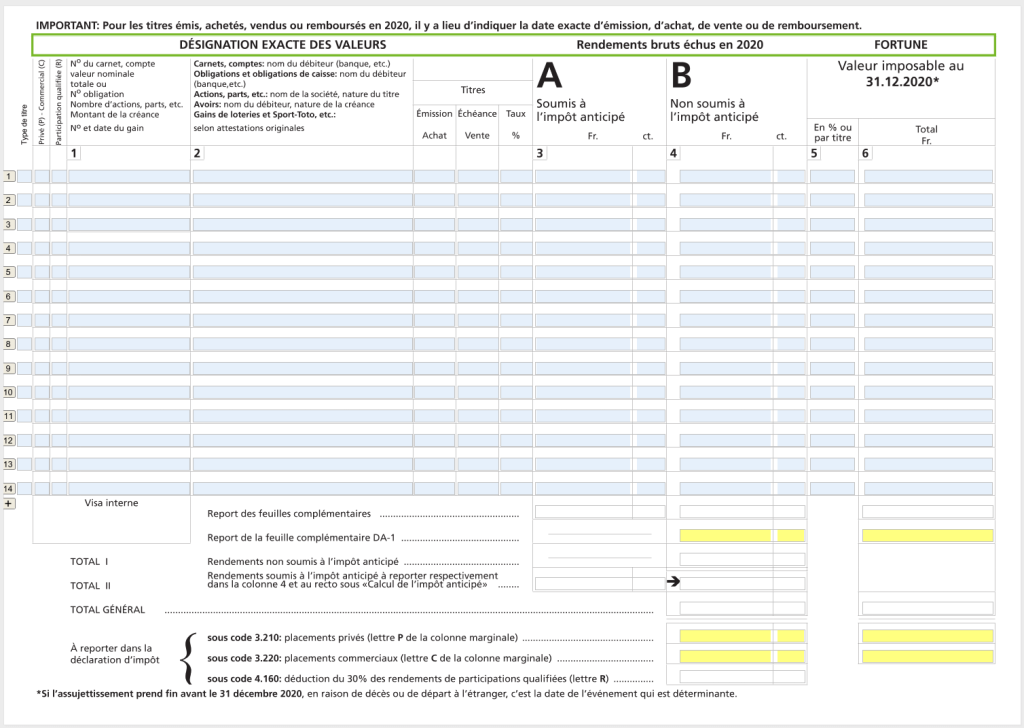
In this form, you must list all of your Swiss securities, whether stocks or ETFs. Since I am recommending investments in ETFs, I will take an ETF as an example. But you would do exactly the same with a stock. For example, I will use CHSPI, the Swiss ETF I use in my portfolio.
You must indicate this is a security (choice 3) in the first column on each line. You must then indicate that this is a private asset (choice P) in the second column.
Then, you can press the “Listes des cours” (Lists of prices) to search for the prices of a security. This assistant will help you with your dividends and prices. You can enter the ISIN number of your ETF and press search (Chercher). For instance, the ISIN number of CHSPI is CH0237935652. You can find the ISIN number of each ETF on the website of the fund provider.
Then, you will see all the taxable income for this security. You can enter the number of shares, the buy date, and the taxable value, and the taxable dividend will be calculated for you. For instance:
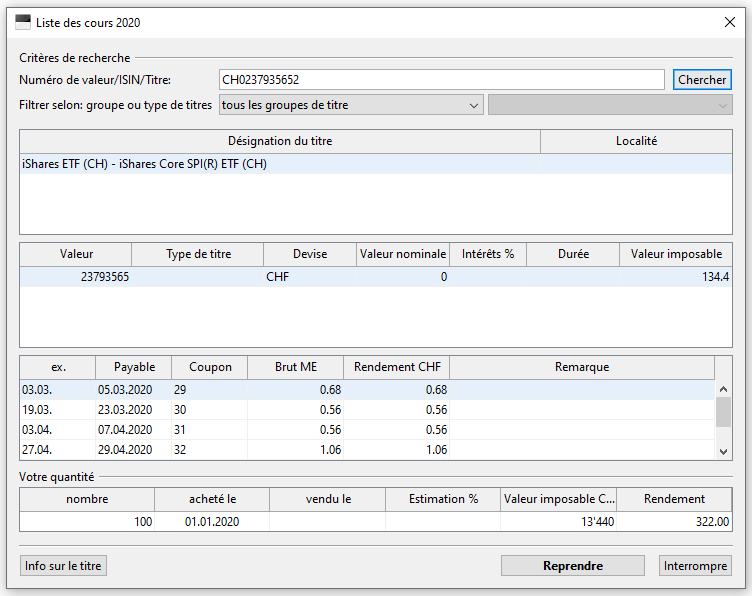
The date will be considered to compute the dividends for this security. If you enter a date that is after some dividends have been issued, they will not be considered. And they will automatically compute the taxable wealth with the security value at the end of the year.
Here is an example of what this could look like.

The totals are automatically done at the end of the form. And these values are propagated into the rest of the forms.
If you already have securities before the beginning of the year, you have two options. If you file your taxes right after the year without losing your tax declaration, you can keep all the buy operations from the previous year. Or you can use the total number of shares at the beginning of the year with a single entry and a date like the last year of the previous year. I have already done that in the past, and I have never had any issues.
If you have sold securities during the year, you must also declare them. You can use a purchase date and sold date to let the software compute how many dividends you received before selling the shares. In that case, the software will automatically set the taxable value to zero.
Using ICTax
Unfortunately, not every Swiss taxes software allows you to get all these numbers inside the app. So, in this case, you will have to use the ICTax website. This is the reference for all the official end-of-year prices and currency conversions to file your taxes. One good thing is that this website is available in English, contrary to the tax software.
You can go to the website and search for the ISIN again:
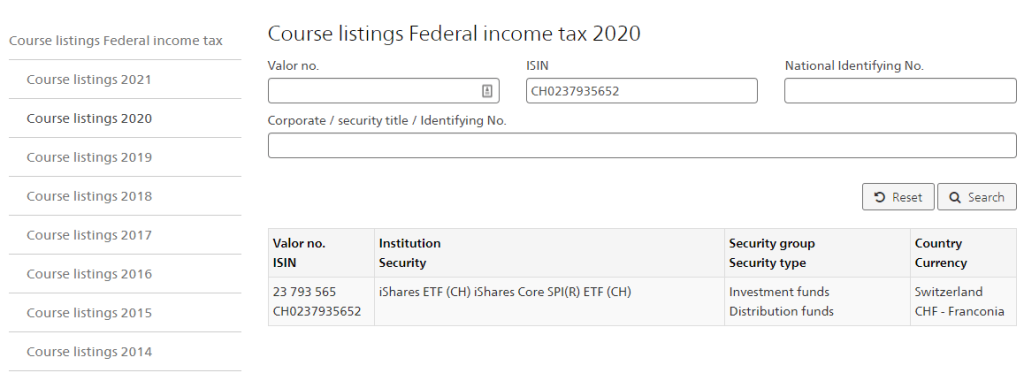
And then, you can click on the ETF of your choosing. After that, you must do the same as before with the tax software. You will be able to enter the number of shares and purchase date. The website will automatically compute the tax value and the gross return. You can then copy these values directly into your tax declaration.
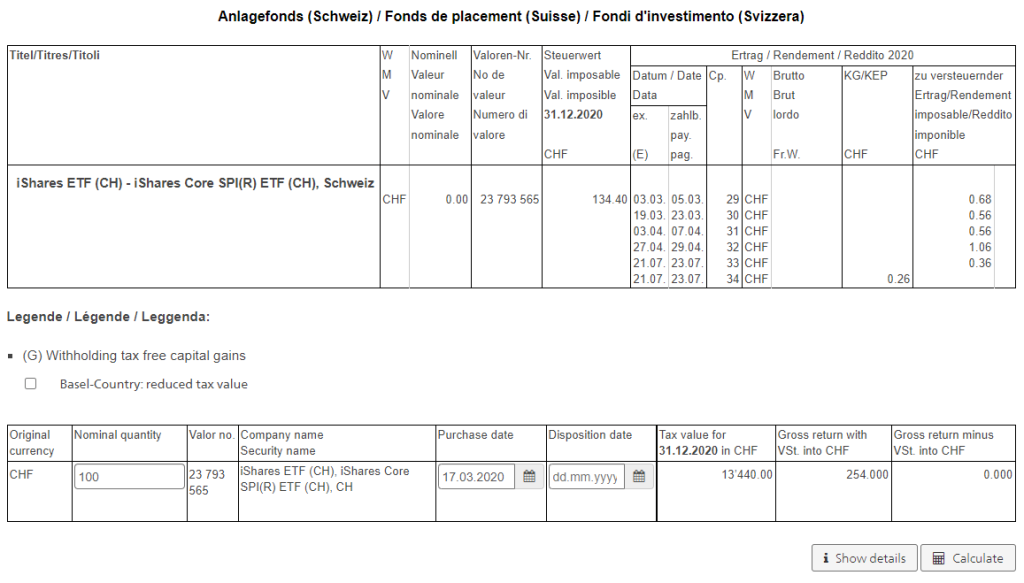
It is much less practical to file taxes like this than having the software do it for you. But in any case, it should not take you long to complete your Swiss securities.
It is also a good reason to keep your trading limited to a few ETFs. If you are buying many securities during the entire year, you will have to enter many lines. But it is not as complicated as many people believe.
If your ETF is not on ICTax, you can ask them to add it to the system. But most well-known ETFs should already be there. I have never had an issue so far.
U.S. ETFs / Securities
For U.S. ETFs and securities, it can get a little more complicated because there are a few possible cases.
First, it will depend on which broker you are using. If you are using a Swiss broker, you will pay two deductions:
- 15% withheld by the Swiss broker
- 15% directly withheld at source by the Internal Revenue Service (IRS)
If you are using a broker like Interactive Brokers, you will only see the IRS’s direct deduction. This is a foreign tax.
You need to use the DA-1 form to claim back foreign tax. You need to use the R-US 164 form to claim back Swiss withholding if you use a Swiss broker.
These forms are attachments to the form we covered in the previous section. And they are extremely similar. The difference will be in setting the percentages that you can claim back.
If you use other foreign securities, the idea remains the same, except that the percentages will differ. You will have to find the percentages for both columns for your situation.
In this case, Fritax did an excellent job since they put DA-1 and R-US 164 together. Therefore, there is only a single form to fill for foreign securities. This is a great idea!
Here is the empty combined DA-1 / R-US 164 form:
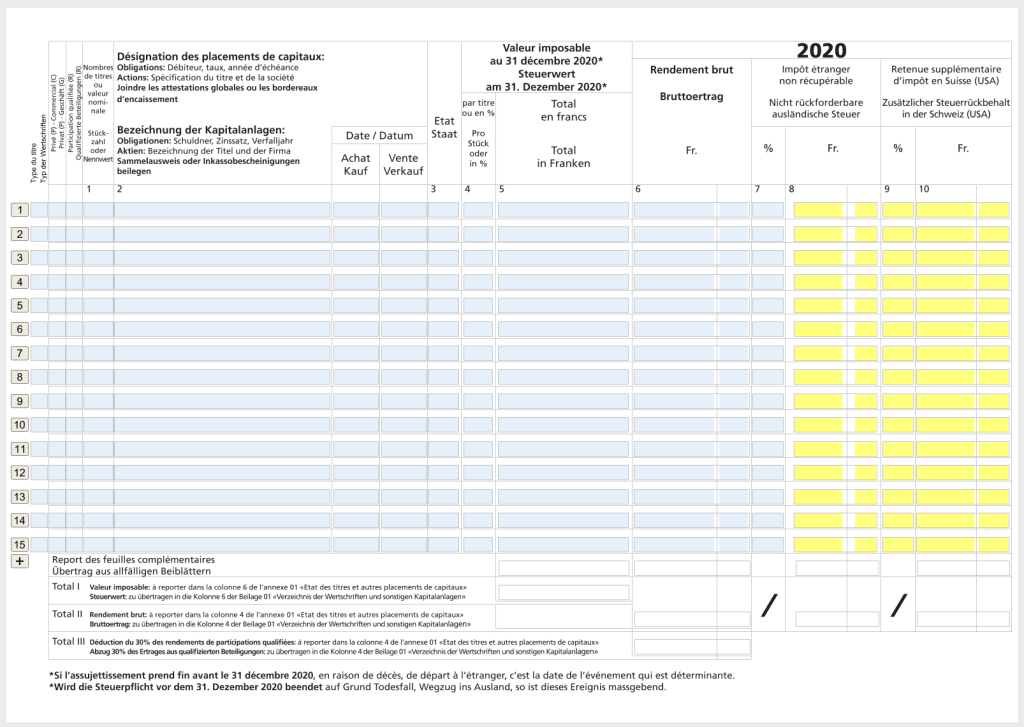
As we can see, it is extremely similar to the previous form. And it works exactly the same way. You must still select that this is an action and part of your private net worth. Then, you can use the same assistant to get all the tax information by pressing the “Liste de cours” button on top of the form.
They have all the information, even for U.S. ETFs, such as Vanguard Total World (VT). Here is an example of how to fill it with VT:
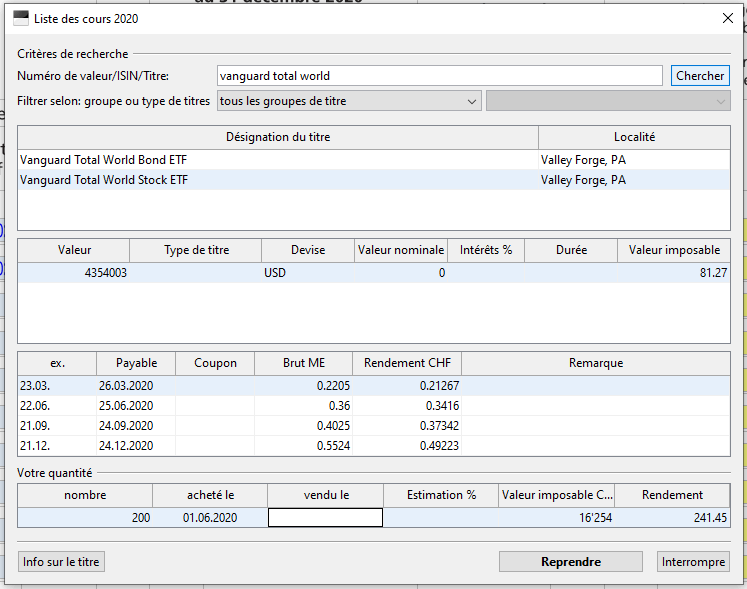
Once you have filled a line, you still need to select the country in column 3. This will be the US in our case.
Then, you need to update columns 7 and 9 with the percentages for your case. If you only fill the DA-1 form (with Interactive Brokers), you must set column 7 to the value 15. If you are filling the R-US 164 form (with a Swiss broker, for instance), you must set column 9 to the value 15.
Then, the tool will automatically compute how much taxes were withheld in both cases. And Fritax will automatically fill in the total.
Here is a filled DA-1 form with both sides filled:

If you use Interactive Brokers and only pay 15% of dividends withholding, you can change column 9 to the value 0.
All the other details are the same as for the Swiss securities, so you can look at the previous sections to get all the information. But with the Fritax software, it is not that bad to file your taxes with foreign securities. As you can see, the DA-1 and R-US 164 forms are almost the same as the standard securities form.
It is important to note that the DA-1 deduction is generally only applied if you have more than 100 CHF in foreign withholding. It does not change how you file your taxes, but knowing this may avoid a surprise when receiving your tax decision.
Using ICTax
If your tax software does not support getting the values directly from it, you can use the ICTax website for foreign securities too. It will give you all the dividends in CHF and the tax value of your securities at the end of the fiscal year.
This will be done exactly like we did for Swiss securities. For instance, you can search for Vanguard Total World on the website:
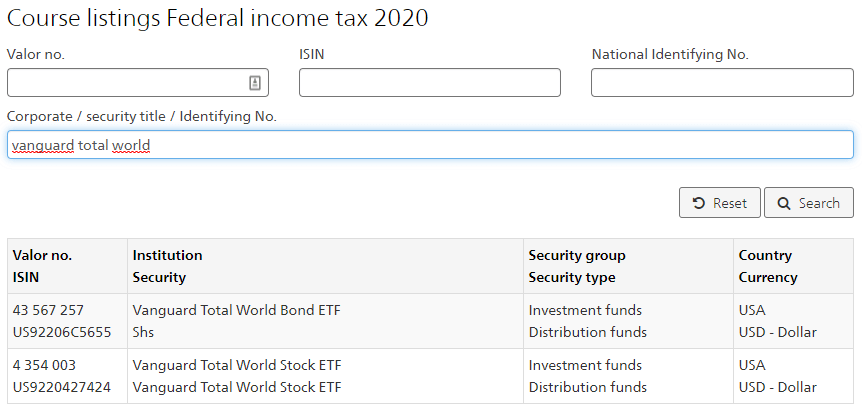
Make sure you choose the Stock version and not the bond version (unless you have both, of course). And then, you can fill it up like before. For instance:
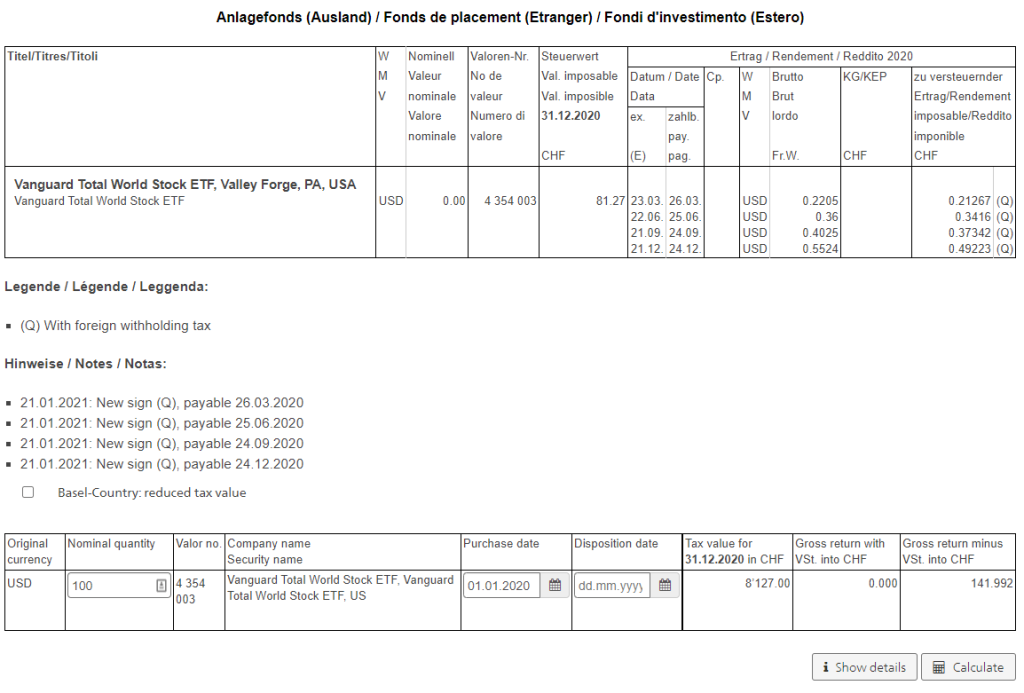
Then, you will only have to copy these values into the DA-1 or R-US 164 form and select the correct withholding percentages. It is not more complicated than for Swiss securities.
Attachments
The tax office will request documents attesting to your dividends, capital gains, and net worth.
Some Swiss brokers will propose some special documents for taxes. And some people believe that only these reports are valid. But that is not correct. Even foreign brokers have documents that Swiss tax offices accept.
For instance, I use an annual activity statement report with Interactive Brokers. This contains all operations, all dividends, and the status of my shares at the end of the year. I have never had any issue with that. You can get this from the Reports tab. In there, you can generate an activity statement for the entire year.
Conclusion
There you have it! Following these simple steps, you can file taxes with Swiss and foreign securities! It is not as complicated as many people believe.
Even for U.S. Securities, it is not complicated. You must fill out an extra form (DA-1) in the best case and two in the worst case (DA-1 and R-US 164), but these forms are almost the same as for Swiss securities. So, I do not think this is a big deal.
If you are wondering why we need to fill all these lines, it is for the system to compute exactly how much you got from dividends. Since dividends are taxed as income, this must be precise. And only by indicating each buy and sell date will you get a precise amount.
Hopefully, this will help you file your taxes with securities.
If you want more tax information, I have an in-depth guide about Swiss taxes.
Download this e-book and optimize your finances and save money by using the best financial services available in Switzerland!
Download The FREE e-book
Dear Baptiste Wicht,
I am a resident of Switzerland and have been following your personal financing blogs for almost 2 years now. They are easy to follow and helpful, many thanks for writing.
Could you please guide in declaring crypto. hich form to use and how to declare them
Regards
Thanks for your kind words!
I don’t know exactly how to declare crypto. I would declare them simply as an asset, but I don’t own them. I won’t write much on crypto unless I start to invest seriously.
Hello!
First of all, great job with the website!
I just moved to switzerland from Portugal, and I have a question:
I am a Swiss resident, with Portuguese nationality. I invest only in DEGIRO, monthly, and only in accumulating ETFs (IE00BYZK4552, IE00B4L5Y983, IE00BG0J4C88, IE00BYZK4883, IE00BGL86Z12, IE00B4L5YC18, IE00BFMXXD54).
As the name indicates, the dividends are accumulated and not distributed to my bank account.
Do I need to declare these? In Portugal, if the ETF are accumulating, I did not need to declare.
Thanks in advance for the help.
Hi Nuno,
Yes, you will need to declare the “virtual” dividends. In most tax software in Switzerland, you can do that for each ETF and they compute the dividends.
Dear Baptiste Wicht,
I am a resident of Switzerland and have been following your personal financing blogs for more than a year now. They are easy to follow and helpful, many thanks for writing.
In addition to investing in the EU, and Switzerland I would like to also invest in ETFs from north America (VOO, VTI etc).
I do have an account with Interactive Brokers UK and would like to know if there are any restrictions for a Swiss resident pertaining to FinSA KID which is similar to PRIIPS KID for the EU.
Many thanks in advance.
Best regards,
Dave
Hi Dave,
Thanks for your kind words!
There are currently no restrictions for Swiss residents to buy US ETFs. Some brokers (DEGIRO, for instance) blocked them when PRIIPS came, but PRIIPS doesn’t apply to us. And IB still lets us invest.
Cheers
Hi,
How does one fill out the form in case of stock that split during the year? For example, I bought NVIDIA stock in 2020 and it split 1:4 in 20 July 2021. I still have it. Both ICTax and the official/implicit tax program for Ticino are completely ignorant of the split. If I put the original number of shares (let’s say 100 shares at 1.1.2021), then the dividend is 4 times too low for the quarters after the split and the wealth at the end of 2021 is incorrect (4x less). If I put the number of shares after the split (400), then it shows that I received 4 times more dividends than I actually got for the first 2 quarters.
Considering that the stocks are down significantly compared to 31.12.2021 (NVIDIA is -42.5%), is there any way not to pay tax on the unrealized wealth?
Thanks.
Hi Dan,
Interesting question and I have no idea :)
I would contact the tax office to know what to do in that case.
As for not pay tax, I am not sure I understand, you will have to pay taxes last year on 31.12.2021, but maybe you will pay less taxes in 31.12.2022.
Hello Dan,
I believe that manually adding or substracting the difference in number of shares (like if you had bought or sold them) with the indication of split should do the trick, but please check with your tax authorities who will gladly help you out.
Hi,
Any idea how to declare capital gains from day trading for a non professional. My portfolio is full of buy sell buy sell throughout the year. No dividends.
Thanks
Hi Dipak,
My thoughts would be that you have to declare each buy and sell operation for the tax office to compute capital gains.
But if you want to be sure, you can contact the tax office of your canton.
Hi Baptiste,
I thought capital gains were not taxed in Switzerland for private investors?!
However, perhaps too many operations would qualify Dipak as professional investor and that would change?
Yes, that was exactly my point. The criteria to define a professional investor and a private are based on the volume of trades, the time holding before selling, and the total number of capital gains. So, not declaring them would mean the tax office won’t have the numbers for qualifying as a professional or private investor.
Now, it’s entirely possible that they don’t need each operation, but only the main ones. I have always written down everything, but maybe we can simplify this. And it very likely depends on each canton.
Good morning Baptist,
Hope you are doing very well those days.
I am wondering to know if you could please explain to us how does IBK really calculs the Net Asset Value %, the Time Weighted Rate of Return and the general loses in the portfolio. (would you make an example please)? Recently, I have seen a 3% Time Weighted Rate of Return, a negative realized & Unrealized Performance Summary of -1000 and a Mark-to-Market Performance Summary of 300. However, the difference between what I have invested related to what I have now is 100 chf. So, I do not understand well how this numbers are calculated. My idea is to be able to calculate what is the % over what I have invested.
Also, what is the right field (lose/gain) I would need to choose for filling the taxes in Switzerland next year. (I see mark to market, p&l, rate of return columns). Thanks a lot, since its quite confusing…and 100 chf is not the 3% of what I have invested in the beginning…
MARA
Hi MARA,
I don’t know the details. It’s complicated because some of these metrics include currency variations. IBKR has a page about their metrics. I hope this helps.
As for the taxes, you don’t need any specific numbers, only the buy and sell prices will be enough.
Hello,
Your blog is great, they are a lot of good explanation, then thanks a lot !
I’m filling my taxes for the first time with some ETFs and i didnt understand very well some thing.
I’m Swiss and i used only Degiro in 2021, European ETFs should be fill up in the “Etat des titres page 2” and not in the DA-1 section ? DA-1 is only for US ETFs ?
How works dividende pourcentage with European ETFs ?
What is DA-3 ?
Thanks by advance.
Hi Steve,
Thanks :)
I would say it depends on where your ETFs are from. If you are using Ireland ETFs, there should be nothing you can get back indeed. DA-1 is not only for US ETFs, but for ETFs, it’s indeed mostly used for US ETFs. I am not aware of any other ETFs that would use it and that is broadly used.
DA-3 is for actual taxes from other countries, excluding dividends and interests.
The ETFs are from different country, France, Luxembourg and some are from Ireland indeed, and that’s the only country that i cant selected in Fritax.
For next year taxes i will need to put US ETFs too, so your article will still help me !
Thanks a lot for the respond.
In any case, you are required to declare your dividends since this is taxed as income. But reclaiming the lost withholding is not required and if we are talking about a few dollars, this may be a futile exercise.
Good luck doing it entirely next year.
Hi good night.
The cantonal tax office has said that I can declare my IB account using the “Mit Depot-/Steuerauszug hinzufügen” and “Konto” options, presenting also the IB annual statement. But I don’t understand very well how to fill these paragraphs.
My portfolio is formed by abroad European stocks with witholding tax in the dividends.
In “Mit Depot-/Steuerauszug hinzufügen” I have four options:
1.Werte mit eidgenössischem Verrechnungssteuerabzug
2.Werte ohne eidgenössischem Verrechnungssteuerabzug
3.Werte mit Anrechnung ausländischer Quellensteuern gemäss DBA (I understand I shall use this).
4.Werte mit zusätzlichem Steuerrückbehalt USA
I think I shall use the case 3. But how to fill it? I have these fields:
-Steuerwert 31.12.2021: I understand this is the net value of my stocks the last day.
-Ertrag: Is this a percentage? What to write here?
-Betrag für die Anrechnung ausländischer Quellensteuern: Is this a percentage? What to write here?
On the other hand, in the Konto I understand I shall add the cash at 31.12.2021 in my IB account, shalln’t it?
Thank you very much for the help. Have a nice weekend.
after talking with the tax office of my canton, they have said to me that it is possible to declare only the net value of my IB account presenting a Steuerauszug.
Concretely, I must make two steps (I’ve understood):
-Finanzen::
Hi,
I am sorry, but I don’t speak German so all these words are alien to me. Automatic translation does not really help.
The cash in IB is declared like a bank account indeed, with the value at 31.12.
As for the rest, I have always declared each action separately.
Hi Baptiste,
thanks a lot for you blog, it is really well done, we are lucky to have you :)
Just a question: I noticed that you didn’t speak about how to declare the cash that you have inside your Interactive Brokers account.
I wonder, how do you declare them? Do you account for them when you declare all your cash (in Zurich would be “Bewegliches Vermögen”, which is basically all the cash that you have in all your bank accounts, like your Privatkonto) or you have to declare them together with your securities (in ZHprivateTax it looks like you can add a bank account and the taxable cash you have inside, but I am not if this is the right place).
Thanks a lot for the answer
Best
Luca
Hi Luca,
Good question :) I declare it as I would any bank account. So, I declare it next to Neon. I have not had a complaint yet. And usually, this is a very small amount since I am as invested as possible.
ok, perfect, thanks a lot for the help :)
Hi Baptiste
“If your ETF is not on ICTax, you can ask them to add it to the system.”
How does one do this? I cannot find a link anywhere.
Thanks
Hi Robbie,
I would contact your local tax office and ask them how to do it.
Mr. RIP managed to do it and shared some information on his blog, this should be helpful: https://retireinprogress.com/that-time-when-i-made-an-etf-available-on-ictax/
Thanks Baptiste for the response and link. After contacting my local tax office with a request to add one ETF, it was added quickly.
My situation is that I used to have a financial advisor in a European country which invested into 20-30 funds, most of which are accumulating and not on ICTax. Let’s hope I can add most of them! And this has finally given the motivation to move this legacy investment to some simple diversified index funds.
Well done!
And good luck simplifying your investments, it’s often a good idea to go with simple!